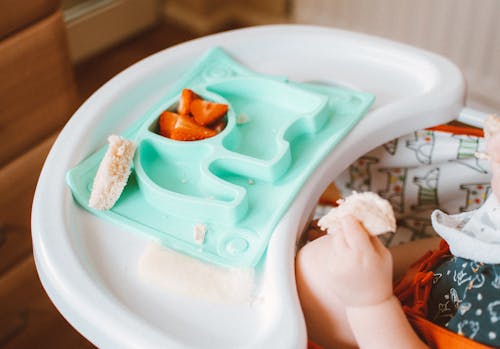It’s totally normal to feel worried about starting your child on solid foods. It’s a big transition for them to make and it’s a journey that will take months not days. It’s daunting to face into, but once you begin, you’ll start to see the enjoyable side of it, seeing your child explore the world around them through food and discovering new things.

Introducing solids is a three-stage cycle, that should be started – at the very earliest – at four months old. The HSE recommend that you breastfeed exclusively for 6 months, but acknowledge that babies develop differently and that for some, it’s appropriate to begin at 17 weeks (4 months). Starting before that is dangerous as their kidneys are not mature enough to handle food and drinks other than milk, their digestive systems are not yet developed enough to cope with solid foods and introducing solids too early can increase the risk of obesity and allergies in later life.
However, the flip side of that is that you shouldn’t wait longer than 26 weeks (6 months) to begin because at that point, breast milk can no longer fulfil their nutritional needs, they need to begin learning important skills like self-feeding and their energy levels require more nutrition.

But how can we tell between 4 and 6 months when they’re ready?
Your baby will start to give you signs that they’re ready to start trying solids. A major one is when they’re able to sit up with support and can control their head movements, or they can look at food, pick it up and put it in their mouth by themselves.
However a baby is not ready just because they are chewing their fists, waking in the night when they have previously slept through, or if they require extra milk feeds now and then. Hunger is not necessarily a sign of interest in solids.
The first steps:

If you’re nervous about beginning this process, just remember that it’s fine to take it slowly. Start with introducing solid puréed foods one a day, and just a teaspoon of food per meal, followed by their breast milk. This is something you can increase as you progress.
Don’t start with lots of different foods. Pick one for the moment allow baby to get used to it, This is a whole new taste and experience for them, so don’t stress over quantity at the beginning, and definitely don’t rush or force feed them.
Never leave baby alone while eating to prevent choking and be sure not to re-use food that hasn't been eaten as this might make your baby ill, cooked food shouldn't be reheated more than once and don't add salt, sugar or stock cubes to your baby's food or cooking water.
After about two or three weeks you can start to up their solids intake and introduce a second meal once they’re hitting the 6 teaspoon mark at meal 1. Because this is a new experience for them don’t be surprised if your baby is spitting out solids to begin with. They’re getting used to the taste and texture of this new food. If they refuse the new food, don’t force them. Move on to a different food and wait a week before offering the refused food again. This could take lots of tries, so don’t give up!
The three stages to be aware of are:
Stage 1: at about 6 months, not before 4 months
Stage 2: between 6 to 9 months
Stage 3: between 9 to 12 months
Start with foods that make you comfortable, softer, nutrient-dense foods.
Stage 1: 4-6 Months

Steamed, puréed veggies – pumpkin, carrot, sweet potato, zucchini, green beans, turnip, broccoli, butternut squash
Puréed fruits - banana, stewed apple, peaches, apricots, melons
Start with 1 teaspoon of food made into a soft smooth purée and build up to 6 teaspoons at one time. Next, introduce solid food at another mealtime, before progressing to 2 to 3 meals per day, with 5 to 10 teaspoons at each meal. Introduce one new food at a time, every 2 to 3 days.
Stage 2: 6-9 Months

Well-cooked egg yolks
Soft cereals – porridge, Weetabix, Readybrek
Pasteurised cheese
Yoghurt
Protein - meat, poultry, fish, peas, beans, lentils
Grains - bread, rice, pasta
Should be moving up to 3 meals a day now, with each about 2 to 4 tablespoons of food. You baby can have 2 to 3 snacks in between main meals, consisting of finger foods and food should always be offered before a milk feed. They may begin to drink some drink from a cup or beaker.
Stage 3: 9-12 Months
Lumpy/ chopped foods and harder finger foods with a wider variety of foods and textures should be introduced now. They should be having 3 meals of about 4 to 6 tablespoons and 2 to 3 snacks, as well as being able to manage more than 2 textures in one meal. All drinks, other than breastfeeds, should be taken from a cup or beaker
What NOT to feed them:
honey or sugar
unpasteurised cheese
salt, gravy, packets or jars of sauce or soup
undercooked eggs
bran
tea or coffee
liver
processed or cured meats, such as sausages, ham, bacon
high fat or high sugar foods, such as crisps, chocolate, cake, sweets
whole or chopped nuts - as there is a risk of choking
Never add rusks, cereals or other foods to your baby's bottle of milk. It makes the milk too concentrated and may be harmful to them.
And most importantly, never leave a baby or young child alone during feeding and ideally feed them during family mealtimes.







